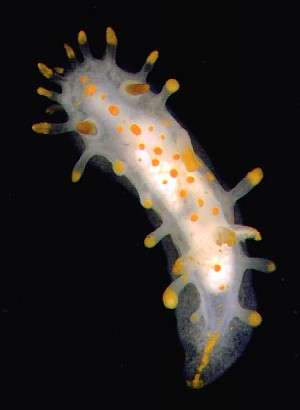
Limacia clavigera
(Muller, 1776)
Order: NUDIBRANCHIA
Suborder: DORIDINA
Family: Polyceridae
Subfamily: Triophinae
DISTRIBUTION
Atlantic coast of Europe, including the British Isles, and from Norway to the Mediterranean. Gosliner (1987) reports it from South Africa where it is common in the kelp beds of the Cape Province.
PHOTO
Burghsluis, Oosterchelde, south west Netherlands, June 1999. (see message, and more photos, below). PHOTO: Peter H. van Bragt.
Easily recognised by its colour and cerata-like papillae around the mantle edge. Grows to about 20mm. In Europe its usual food is the encrusting bryozoan Electra pilosa.
Reference:
• Muller, O.F. (1776) Zoologiae Danicae. Prodromus seu animalium Daniae et Norvegiae ingenarum characteres, nomina, et synonyma imprimis popularium, p. I-XXXII, 1-242.
Rudman, W.B., 1999 (July 23) Limacia clavigera (Muller, 1776). [In] Sea Slug Forum. Australian Museum, Sydney. Available from http://www.seaslugforum.net/find/limaclav
Related messages
Re: Limacia clavigera from French Mediterranean
March 21, 2008
From: Dominique Horst
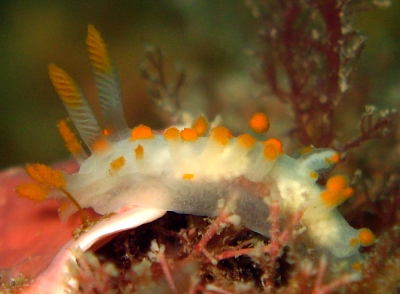
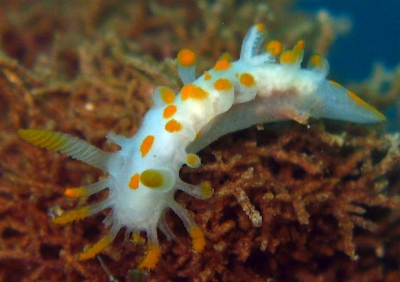
Concerning message #7594:
Hello Bill,
It's a kind of explosion of sea slug in the French Mediterranean these last weeks, and a very rich time with many different species.
So even if I have the feeling I am just the following in Marina's footsteps -a few years later - I cannot resist sharing on the forum the new species I meet.
This is Limacia clavigera probably feeding on hydroids (see photo 2).
Locality: Antibes, 10m, France, Mediterranean sea, 16 March 2008. Length: 10 mm. Photographer: Dominique Horst.
Kind regards,
Dom
dominique.horst@wanadoo.fr
Horst, D., 2008 (Mar 21) Re: Limacia clavigera from French Mediterranean. [Message in] Sea Slug Forum. Australian Museum, Sydney. Available from http://www.seaslugforum.net/find/21456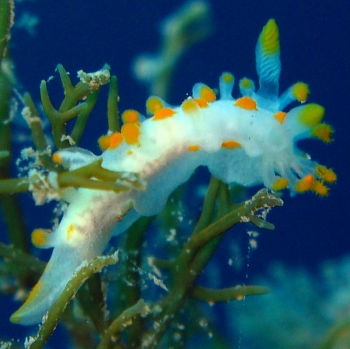
Dear Dom,
It is good to get more photos of the Mediterranean fauna. Much of the early work on opisthobranch biology was based on European species and yet, compared to the Indo-West Pacific fauna, we have few published photographs of the living animals from that part of the world.
Concerning its food. It has only been reported to feed on bryozoans, and the branching colony in photo 2 looks more like a bryozoan than a hydroid colony.
Best wishes,
Bill Rudman
Re: Limacia clavigera and possible egg mass
November 14, 2007
From: Jeff Goddard
Concerning message #20643:
Hi Bill,
I checked Thompson and Brown's (1984) monograph for an illustration of the egg mass of Limacia clavigera, and they depict a spirally wound, thick cord containing small eggs, so it is unlikely that the ribbon-shaped egg mass with large eggs in Joao Pedro Silva's message [#20643] belongs to this species.
Based on information in the recent paper by Sanchez Tocino et al. (2007), as well as Joao Pedro's image in message #16878 of Hypselodoris villafranca mating out in the open on algae, I suspect that the egg mass in message #20643 was laid by H. villafranca. I will, however, defer to the opinion of my colleagues more familiar with the fauna of the NE Atlantic.
-
Sanchez Tocino, L., A. Ocana, F. J. Garcia and J. L. Cervera. 2007. Description of the egg masses and development of some Doridoidea (Mollusca: Nudibranchia) from southern Iberian Peninsula. Iberus25(1):1-20.
-
Thompson, T.E. and G.H. Brown. 1984. Biology of Opisthobranch Molluscs Vol II. Ray Society, London.
Best wishes,
Jeff
goddard@lifesci.ucsb.edu
Goddard, J.H.R., 2007 (Nov 14) Re: Limacia clavigera and possible egg mass. [Message in] Sea Slug Forum. Australian Museum, Sydney. Available from http://www.seaslugforum.net/find/20779Thanks Jeff,
Bill Rudman
Limacia clavigera mating
November 14, 2007
From: Christian Skauge
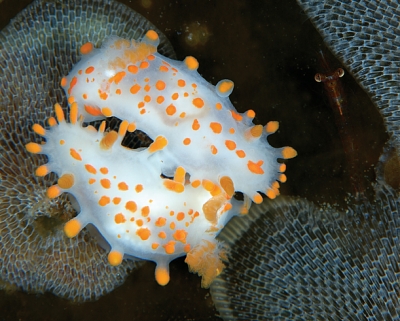
Dear Bill,
I came across a beautiful pair of Limacia clavigera mating on a kelp frond, and thought you'd like to have the image postet on your site.
Locality: Myken, Helgeland Coast, 8-10 meters, Norway, Atlantic Ocean, 08 August 2007, Kelp forest. Length: Approx. 30 mm. Photographer: Christian Skauge.
Christian Skauge
post@dykkefoto.no
Skauge, C., 2007 (Nov 14) Limacia clavigera mating. [Message in] Sea Slug Forum. Australian Museum, Sydney. Available from http://www.seaslugforum.net/find/21097Thanks Chris,
Your photo is very welcome
Best wishes,
Bill Rudman
Limacia clavigera and possible egg mass
September 21, 2007
From: Joao Pedro Silva
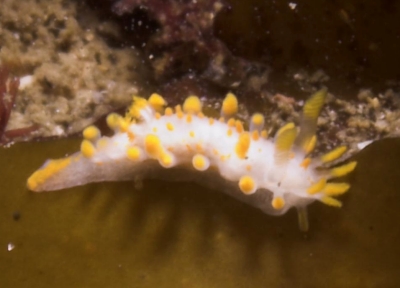
Dear Bill,
Another one of yesterday's findings (I promise it's the last one!). Here are two photos of the same algal leaf, one of each side. I know one cannot be sure the eggs come from a particular species unless we see an individual laying them but this Limacia clavigera crawling so near makes a strong suspect. On the other hand, I've never seen L. clavigera spawning so I don't know what the egg mass looks like.
Locality: Peniche, 10 metres, Portugal, North Atlantic, 02 September 2007, Rocky bottom. Length: 15mm. Photographer: Joao Pedro Silva.
Cheers,
Joao Pedro
jpsilva@uwphotographer.net
Silva, J. P., 2007 (Sep 21) Limacia clavigera and possible egg mass. [Message in] Sea Slug Forum. Australian Museum, Sydney. Available from http://www.seaslugforum.net/find/20643
Dear Joao Pedro,
Thanks for your messages. They are always welcome. I am not sure if this is the egg ribbon of Limacia. One problem is that you give no indication of the size of the egg ribbon relative to the size of the slug. All I can say is the eggs are quite large, suggesting whatever slug produced them may have an abbreviated larval life, perhaps with the larvae hatching out as tiny crawling slugs rather than swimming veliger larvae..
Best wishes,
Bill Rudman
Limacia clavigera from Brittany, France
January 10, 2006
From: Stephane Ores
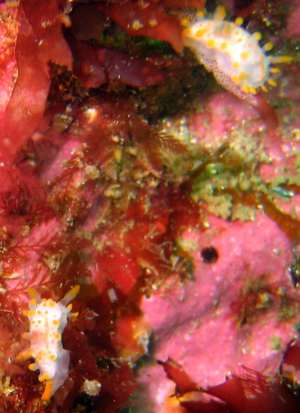
Hello !
I saw this Limacia clavigera in June, 2005, in Brittany, Belle-Isle (France)
10 m deep, near fragments of the bryozoan, Electra pilosa
Locality: Belle-Isle, Brittany, France. Atlantic Ocean. Depth: 10 m. Length: 20 mm. 11 june 2005. good visibility. Photographer: Stephane Ores
Stephane Ores
stephane.ores@neuf.fr
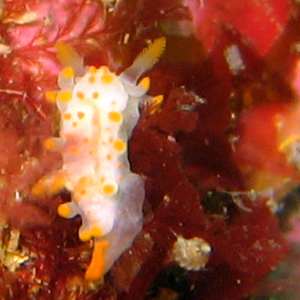
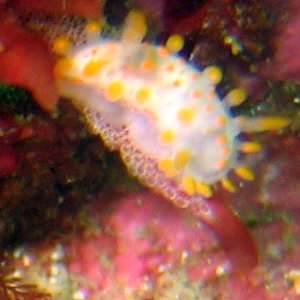
Thanks Stephane,
Bill Rudman
Limacia clavigera in Portugal
October 14, 2005
From: Joao Pedro Silva
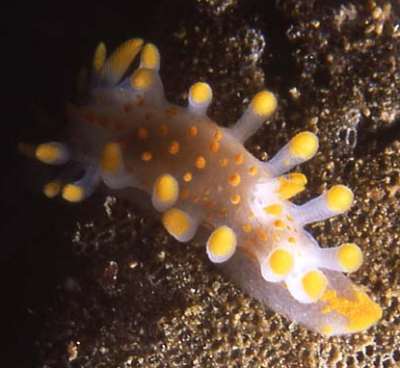
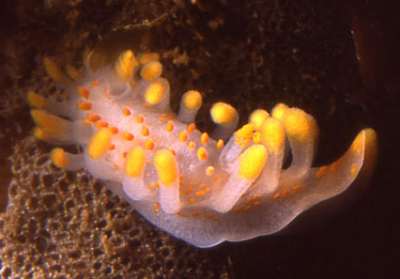
Dear Bill,
Last week me and a couple of friend photographers got together to look for nudibranchs and found several Limacia clavigera (alongside with other species, like Polycera quadrilineata) walking over what's left of the Saccorhiza "forests". The algae were covered with bryozoans and I guess the Limacia clavigera are probably feeding on them. However, you mention on the factsheet that they feed on Electra pilosa but these bryozoans seem to be (at least seem to me) Membranipora membranacea. Could it be they feed on several species?
Locality: Baleal, Portugal. Atlantic. Depth: 6 to 8 meters. Length: Between 0.5 and 1.5 cm. 5 October 2005. Rocky bottom. Photographer: Joao Pedro Silva
Cheers,
Joao Pedro Tojal Loia Soares Silva
jpsilva@uwphotographer.net
Silva, J. P., 2005 (Oct 14) Limacia clavigera in Portugal. [Message in] Sea Slug Forum. Australian Museum, Sydney. Available from http://www.seaslugforum.net/find/14997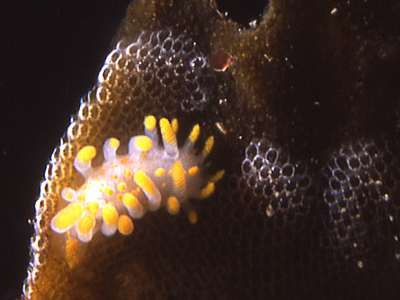
Dear Joao Pedro,
I am not an expert on bryozoans, but this could well be Electra pilosa. It usually has long hairs (hence its the name pilosa) along each side of the skeletal wall, but these are usually longest when it is growing on narrow diameter objects like branching red algae. On more flattened surfaces the hairs are not as well developed. If you look carefully at the photo alongside you can see a row of stumpy 'hairs' on some of the cell walls. Also this is one bryozoan species which tends to change its degree of 'hairiness' depending on the predation pressure it is under. Having said all that, Picton & Morrow (1994) say that although it prefers E. pilosa, it can be found feeding on other encrusting bryozoans.
Best wishes,
Bill Rudman
Limacia clavigera from Turkey
August 19, 2003
From: Ferda Buyukbaykal
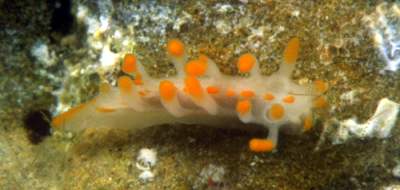
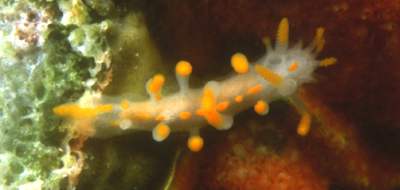
Dear Bill,
Could you identify this photo please? I think it is Limacia clavigera.
Date: August 10 , 2003
Location: Canakkale, Saroz
Site: Minnos Kayalari
Depth: 15-18 mt
Size: 08-10 mm
Photos: Ferda Buyukbaykal
Best regards
Ferda
ferdabbaykal@isnet.net.tr
Buyukbaykal, F., 2003 (Aug 19) Limacia clavigera from Turkey. [Message in] Sea Slug Forum. Australian Museum, Sydney. Available from http://www.seaslugforum.net/find/10776Thanks Ferda,
It is indeed Limacia clavigera.
Best wishes,
Bill Rudman
Limacia clavigera from French Atlantic
May 23, 2003
From: Marina Poddubetskaia
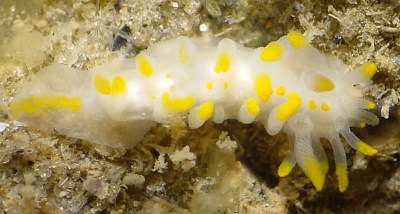
Dear Bill,
Here is another guy, Limacia clavigera from Bassin d'Arcachon.
Location: Bassin d'Arcachon, France, Atlantic coast. Site: Le Roche Velaine wreck.
Depth: 8m, Size: 20mm. May 09, 2003.
Photos: Marina Poddubetskaia - Nembro website
Best wishes,
Marina.
nembro@nembro.info
Poddubetskaia, M., 2003 (May 23) Limacia clavigera from French Atlantic. [Message in] Sea Slug Forum. Australian Museum, Sydney. Available from http://www.seaslugforum.net/find/9950Thanks Marina,
Bill Rudman
Limacia clavigera from French Brittany
September 17, 2002
From: Marina Poddubetskaia
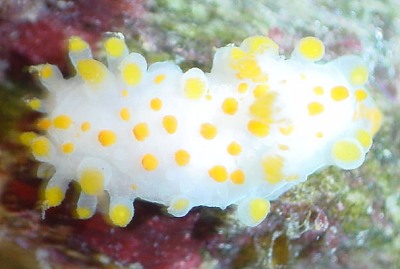
Dear Bill,
Here is a photo of Limacia clavigera from Atlantic Ocean.
Date: August 16, 2002
Location: Belle-ile, Brittany, Atlantic coast of France.
Site: Penhouet
Depth: 10m
Size: 15-20mm
Photos: Marina Poddubetskaia - Nembro website
Best wishes,
Marina.
nembro@nembro.info
Poddubetskaia, M., 2002 (Sep 17) Limacia clavigera from French Brittany. [Message in] Sea Slug Forum. Australian Museum, Sydney. Available from http://www.seaslugforum.net/find/7831Thanks Marina,
Bill Rudman
Limacia clavigera from French Mediterranean
July 28, 2002
From: Marina Poddubetskaia
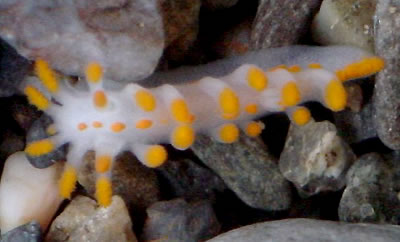

Dear Bill,
Here are some photos of Limacia clavigera. Both photos were taken at Cerbere, on the Mediterranan coast of France
Upper: July 01, 2002, Site: Les 3 moines, Size: about 10mm.
Lower: July 02, 2002, Site: Cap Negre, Size: less than 10mm
Photos: Marina Poddubetskaia - Nembro website
Best wishes,
Marina.
nembro@nembro.info
Poddubetskaia, P., 2002 (Jul 28) Limacia clavigera from French Mediterranean. [Message in] Sea Slug Forum. Australian Museum, Sydney. Available from http://www.seaslugforum.net/find/7594Thanks Marina,
Nice to get some Mediterranean examples of this species.
Bill Rudman
Re: Limacia clavigera from the Netherlands
July 24, 1999
From: Peter H. van Bragt
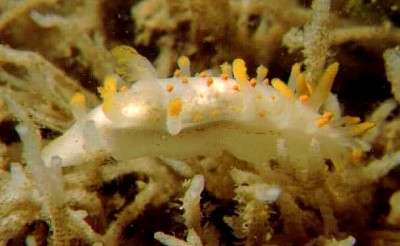
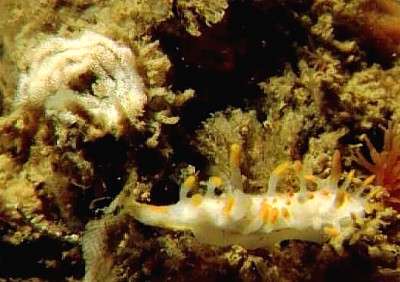
Dear Bill,
Recently you have received a message from Albert Koulman about, Limacia clavigera, another new record of a nudi species for the Netherlands. At Burghsluis, Oosterschelde, the Netherlands, we have found numerous specimens, up to 8 in one dive, of Limacia, including copulating pairs, spawning individuals and egg ribbons.
Enclosed you will find some pictures of this species as they were taken at this specific dive site, including one with an egg ribbon, and one in vitro image.
I hope you like the scans and that you will add them to your Forum.
Greetings from a small country in the northern hemisphere, where nudi spotting can be quite exciting.
Peter H. van Bragt
Peter.vanBragt@ftn.hsbrabant.nl
van Bragt, P.H., 1999 (Jul 24) Re: Limacia clavigera from the Netherlands. [Message in] Sea Slug Forum. Australian Museum, Sydney. Available from http://www.seaslugforum.net/find/1106Dear Peter,
Thanks very much for the excellent photos. I have put your in vitro one at the top of the page. Any more photos of other interesting Dutch finds would be very welcome. The animals in situ seem to be crawling on an erect bryozoan colony. Their preferred food, the bryozoan Electra pilosa is an encrusting form. Is what I see in the photos Electra growing over, and smothering, a branching algae, or is it an arborescent bryozoan?
Best wishes,
Bill Rudman.
Limacia clavigera from Holland
July 17, 1999
From: Albert Koulman
Hi there,
At the and of June Limacia clavigera was seen at coast of the Netherlands for the very first time. We found several slugs in the estuary called Oosterchelde (South West part of the Netherlands). Since the first sighting several divers have reported sightings of this species.
We are trying to get an idea why this species has suddenly arrived in the Netherlands. Electra pilosa is one of the most common bryozoa at our coast, so its diet was always there.
Can anybody help me with sighting near the Netherlands. I have seen this species in Bretany and Ireland, but that is all Atlantic. The only records I have found from the North Sea were from Helgoland and Norway. Has anybody seen this slug on the British eastcoast or Belgium or anywhere else in the North Sea?
Thanks for your help
Albert Koulman
Dept. Pharmaceutical Biology
University of Groningen
A. Deusinglaan 1
9713 AV Groningen
The Netherlands
A.Koulman@farm.rug.nl
Koulman, A., 1999 (Jul 17) Limacia clavigera from Holland. [Message in] Sea Slug Forum. Australian Museum, Sydney. Available from http://www.seaslugforum.net/find/1069Dear Albert,
Any chance of a photo to liven up the page?
Bill Rudman.
